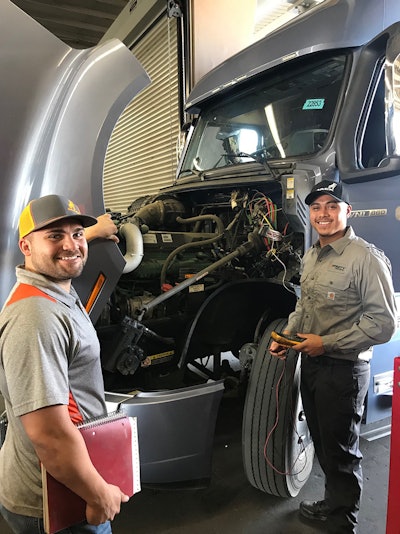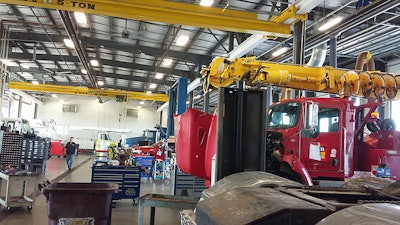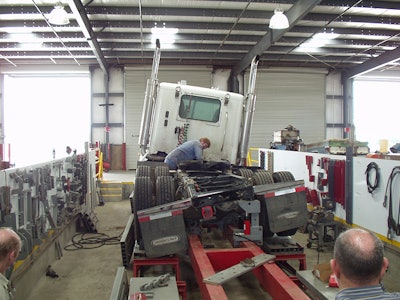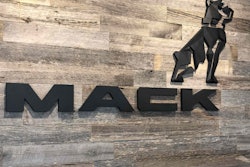 To halt employee turnover and begin building a dependable team of technicians, service providers also must stick the landing. New recruits have to stay.
To halt employee turnover and begin building a dependable team of technicians, service providers also must stick the landing. New recruits have to stay.As employment turnover issues continue to plague the trucking service channel, more businesses are investing resources in the recruitment and acquisition of new technicians. It’s a valid strategy that makes sense considering the need.
But recruitment alone will not solve any business’ employment problems. To halt employee turnover and begin building a dependable team of technicians, service providers also must stick the landing. New recruits have to stay.
According to a 2018 survey by CCJ publisher Randall-Reilly, of more than 1,200 professional technicians in the trucking, agriculture, construction and automotive industries, more than half of today’s technician population has worked for at least two maintenance or repair businesses in the past five years.
In the trucking market, specifically, 56% of the more than 800 technicians surveyed claimed they are on at least job No. 2 in the last five years, and 20% said they’ve had three or more jobs.
Despite the revelation that two-thirds of the heavy truck technicians surveyed by Randall-Reilly also have a vocational degree in their line of work, only 11% said they would not consider leaving trucking for a different industry that offered better wages, training, career advancement opportunities or a favorable location.
For a market desperate to retain talent, such a willingness to exit by the industry’s educated professionals should be alarming to anyone responsible for keeping a technician position filled.
Yet it’s also important to note that while employee retention is getting harder, keeping quality technicians isn’t impossible. Those same surveyed technicians who were so open about their propensity to job-hop also were adamant that such career moves aren’t made on a whim.
Technicians say they leave employers because they feel underpaid and underappreciated. They also admit that when they find an employer that treats them well, they’ll stick around.
In responding to Randall-Reilly’s survey, one technician said he deliberately evaluates a company’s culture when considering a new role. “How much do they value my position?” he asked. “How much do they value their technicians? Being appreciated and valued is really important.”
Several other technicians referenced employee morale and management styles. One said: “The biggest factor for me is the person I work for. People don’t quit jobs, they leave poor management.”
And while other more tangible factors such as salary, benefits and paid time off also were referenced as recruitment and retention tools, the survey respondents made it clear that benefits alone won’t keep every technician happy.
As one technician succinctly said, “I would love to actually be able to work around other professionals that know and understand the industry and make work flow easier.”
In Part III of our 2019 Special Report on trucking’s technician shortage, CCJ seeks to evaluate these comments further, clarifying what technicians desire in their occupation and showing how proactive service providers can develop strong employee retention strategies to reduce turnover.
1. Want them to stay? Pay them
One fact confirmed by Randall-Reilly’s survey is that the best way to retain technicians overwhelmingly continues to be a strong pay structure.
Today’s technicians understand their value to their employers. They realize how much revenue they generate and aren’t willing to work for less than their fair share.
More than 70% of technicians responding to Randall-Reilly’s survey pegged pay and benefits as their top factor when abandoning a job or choosing a new one in the heavy truck, construction, agriculture and automotive industries. Within just the trucking market, pay was the top reason for 72% of responders and the second choice for another 11%.
“Techs know if they are experienced, they can go anywhere and get a job,” said Jim Hinton, service trainer for Summit Truck Group. “They can look for the highest bidder. I don’t think you can reduce your turnover rate without talking about technician wages.”
Yet despite it being a major point of contention, most technicians are earning a living wage. Nearly 60% of heavy truck responders to Randall-Reilly’s 2018 survey reported making at least $50,000 annually, with 38% surpassing the $60,000 barrier and one in 20 technicians (5%) claiming to pull in more than $100,000 per year.
Survey responders say their main issue isn’t so much base pay as much as how their pay corresponds to their value. To quote one responder, technicians believe their pay “should be appropriate” to their duties.
One way proactive service providers are looking to solve this issue is by clearly communicating how an employee’s performance corresponds with their pay and impacts it.
Hinton said Summit has started conducting bi-annual performance reviews of its technicians to give them the potential to earn multiple raises per year.
These reviews, coupled with a new bonus program that rewards employees for completing elective online training courses, have increased Summit’s technician morale and retention.
 Summit Truck Group invests in Navistar’s national technical education program that provides equipment, tools and scholarships to students.
Summit Truck Group invests in Navistar’s national technical education program that provides equipment, tools and scholarships to students.“I think we’ve tried to create a work environment and culture where [technicians] know they will be rewarded for working hard,” Hinton said.
Jordan Schroeder, president for Truck Equipment Inc., hopes to have similar success with a quarterly program his team has developed called “Give Yourself a Raise.”
“It’s a bonus program where we do quarterly updates on how all of our departments are performing,” he said. “We talk about margins, labor efficiencies. The goal is to drill into the details of how each employee can make an impact and give yourself a raise. One of my hopes with the program is we improve our profitability, and that becomes a part of [employees’] pay package.”
Bonuses also can be valuable on an individual basis. Randall-Reilly’s survey indicates more than 85% of diesel technicians are paid an hourly rate — a payment structure that lends itself well to performance-based compensation.
At Affinity Truck Center, bonuses are paid based on technician efficiency, said Chris Paris, service manager. The more hours a technician bills, the more he earns.
Service providers also shouldn’t overlook the value of providing debt relief and reimbursement for technicians, particularly young professionals still burdened by student loans and tool expenses. Hinton said Summit invests in Navistar’s national technical education program that provides equipment, tools and scholarships to students.
Ray Schmidt, service manager for McCoy Freightliner, said his company recently introduced a tuition reimbursement program for interns and part-time associates that pays 100% of a technician’s educational expenses if they maintain a B average and stay with the dealership for two years after graduation.
Service providers say that any method that shows associates how much they are appreciated has value.
“At the end of the day, [technicians] are trying to make a living for their family,” said Charlie Nichols, general manager for TAG Truck Center-Calvert City, Ky.
2. Workplace culture can help
 Inland Truck Parts and Service is committed to offering a top-rate service experience that also helps keep technicians engaged.
Inland Truck Parts and Service is committed to offering a top-rate service experience that also helps keep technicians engaged.Another important takeaway indicated within Randall-Reilly’s survey is the importance of culture in employee retention. While it might not be a technician’s top priority when hunting for a new job, corporate culture has a definite impact on how long an employee hangs around.
No one wants to work where they’re unhappy.
“Obviously, you have to pay a good wage and provide good healthcare benefits, but I think everyone knows that,” said Greg Klein, president for Inland Truck Parts and Service. “I think the other thing that goes together with that is to create a culture where [employees] feel they are a part of something.”
Klein said one way that’s done at ITP is with the company’s employee stock ownership program (ESOP). Employees gain access to the ESOP during their first year and reap the benefits of the program as long as they remain employed with the company.
But Klein said ITP’s low technician turnover rate can’t be attributed entirely to the ESOP. He said the company’s commitment to offering a top-rate service experience also helps keep technicians engaged. Between its corporate training center staffed with four full-time trainers and its many new state-of-the-art service facilities, ITP strives to make its service business the vanguard of the independent aftermarket.
“We want to be perceived as a first-class operation, and we believe people want to be proud of where they work,” Klein said.
A strong corporate culture also can be instilled other ways. A focus on collaboration and positivity has netted a strong service culture for Texas Truck Direct, said Christy Cozby, vice president of operations.
“Guy [Robertson], who runs our service department, has really pushed a team environment, and I think we’ve seen some positive results from that,” Cozby said. “[Sometimes technicians] get hot and frustrated, and it’s so easy to fall into negative behavior. Guy has really been hitting the shop hard with ‘Let’s have a positive outlook. Let’s treat each other with respect.’ If you can maintain a positive environment, it makes it much easier to come into work every day.”
Environment matters, agrees Ian Johnston, vice president of marketing and operations for Harman Heavy Vehicle Specialists.
“We had a bit of turmoil in our department last year, and you could see that wave of morale go down,” Johnston said. “It has gone back up again, but we could see then how much our culture can impact our employees.”
There’s also the matter of resources. The more a service shop does to provide assistance for its technicians, the less likely those technicians will be to seek out other opportunities.
Klein points to ITP’s training center as an advantage in this area. With each of the company’s trainers offering more than two dozen courses per year, ITP technicians have access to training at all times. And at a company where every employee’s investment in their work is literally paid back through the ESOP, most ITP technicians are highly motivated to learn and improve their skillset, he said.
That thirst for knowledge was visible in Randall-Reilly’s survey, as 10% of heavy truck responders reported continuous education/training or access to the latest technologies as their top motivator when searching for a new job — ahead of location, benefits and even pay.
And these resources and technologies don’t refer solely to training or education. Chris Sterwerf, chief financial officer and chief operating officer for Fairfield Auto & Truck Service, said he’s found success supporting technicians through tool purchases and reimbursements — helping employees cover an out-of-pocket expense most young technicians don’t even know is coming until they’ve just begun working in the industry.
“Whether you’re recruiting or trying to keep technicians, you have to do things that make your business attractive,” Sterwerf said. “I think something as simple as tools can go a long way. The cost of tools is a barrier to entry for a lot of young technicians today.”
Sterwerf admits such a move is an investment but said it’s one he’s glad to make to avoid the potential dangers of the status quo.
“I don’t want techs trying to use the wrong tools for the job,” he said. “That just causes more issues for everyone.”
3. Generational perceptions
 Affinity Truck Center operates a two-year apprenticeship program in which new technician hires are paired with veteran mentors to learn about the company and how to be capable technicians.
Affinity Truck Center operates a two-year apprenticeship program in which new technician hires are paired with veteran mentors to learn about the company and how to be capable technicians.One aspect of workplace culture that is overlooked when discussing employee turnover and retention is generational understanding. The work environment that Millennials and Generation Z expect from their employers is different from the Baby Boomer-developed corporate culture found in most of trucking’s service businesses.
While Generation X accepted a workplace culture it didn’t prefer but generally understood, latter generations aren’t quite as malleable. Retaining young professionals in today’s service channel doesn’t require a complete overhaul of one’s business, but it does require a willingness to accept that not all employees have the same personal and professional desires.
One area where this is most evident is in how young professionals approach their career path. Millennials are eager to climb the corporate ladder. Many become disillusioned by long periods in a single role, and some will abandon a steady job with one employer for the potential of career advancement elsewhere.
“That’s very clear with the generation we see coming into the business today,” said Homer Hogg, director of technical service for TA/Petro. “If you don’t show them your opportunities, it is easy for them to think they are stuck in one environment.”
Managing those expectations can be difficult in service operations where promotion opportunities are minimal, but executives and service managers can allay some concerns from young associates by presenting clear expectations necessary to meet pay increases, bonuses or access to a preferred schedule.
That latter point, in particular, shouldn’t be overlooked. Millennials and their Generation Z counterparts aren’t always looking for 9-to-5 jobs. Many are willing to work longer days, nights and weekends to provide flexibility for their personal lives.
Many young associates also are hungry for education and validation. They want to know when they are doing a job well, but they also want to know when they’ve done something wrong. They want to know when they mess up and want to learn to be better. That goes back to their upbringing, said Jim Pancero, professional sales adviser and consultant.
“Millennials have grown up in a rules environment,” Pancero told attendees at Heavy Duty Aftermarket Week 2018. “They didn’t go outside to play. They went to practice. They were taught best practices their whole life, so they’re demanding best practices from your company.”
Service providers can offer that guidance through training and mentorship. Both methods have proven effective at Affinity, which operates a two-year apprenticeship program in which new technician hires are paired with veteran mentors to learn about the company and how to be capable technicians.
Paris speaks glowingly of how the program has helped assimilate young technicians into the company’s ranks, referencing the mentor aspect specifically as an invaluable resource.
“We’ve found that some techs coming out of school can be a little scared at first, a little shy about asking questions,” Paris said. “The [apprenticeship] program has helped with that. It’s gives them someone they can go to so they aren’t asking questions in front of everyone.”
And when those questions are answered and young technicians start thriving, they should hear about that, too, both to validate their performance and to affirm their importance to their employer and the customers they service, said TAG’s Nichols.
“These days, young people want to know their career has meaning and purpose,” he said. “They want their job to have an impact and to make a difference. Being a heavy truck technician is a great way to satisfy those desires, because it’s more than just a job. Keeping trucks up and running is not only important to the driver who is on the road supporting his family, it’s also critical to our overall economy.”
– Bill Grabarek, Truck Parts and Service online associate editor, contributed to this article.
Click here to download the Randall-Reilly technician wage survey
TARGETING TECHNICIANS
Part 1: Trucking industry faces major shortage, opportunities for diesel mechanics
Part 2: Why trucking must change its technician recruitment practices
Part 3: Investment in your business can help retain your best technicians














